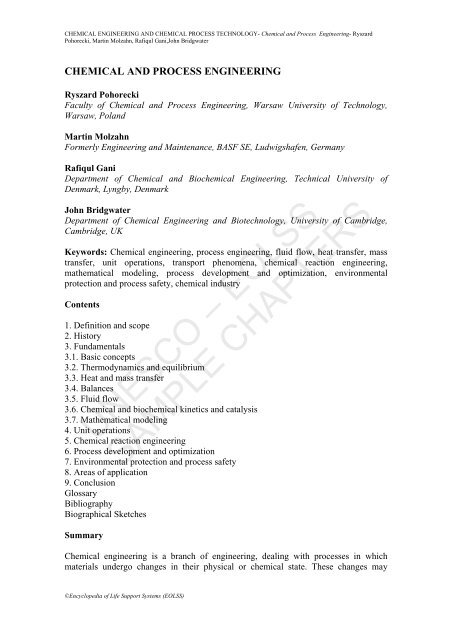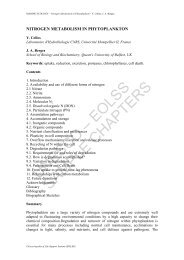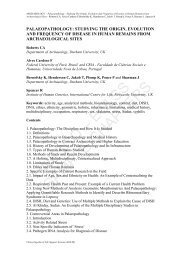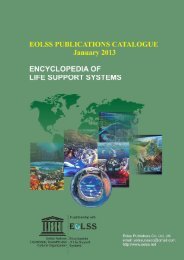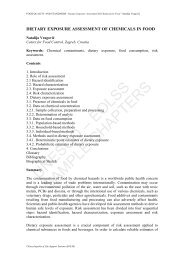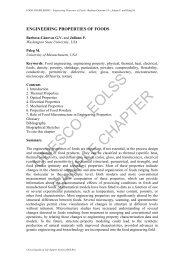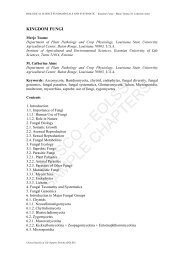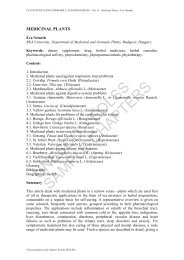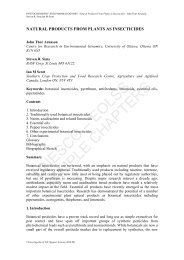Chemical and Process Engineering - eolss
Chemical and Process Engineering - eolss
Chemical and Process Engineering - eolss
You also want an ePaper? Increase the reach of your titles
YUMPU automatically turns print PDFs into web optimized ePapers that Google loves.
CHEMICAL ENGINEERING AND CHEMICAL PROCESS TECHNOLOGY- <strong>Chemical</strong> <strong>and</strong> <strong>Process</strong> <strong>Engineering</strong>- Ryszard<br />
Pohorecki, Martin Molzahn, Rafiqul Gani,John Bridgwater<br />
CHEMICAL AND PROCESS ENGINEERING<br />
Ryszard Pohorecki<br />
Faculty of <strong>Chemical</strong> <strong>and</strong> <strong>Process</strong> <strong>Engineering</strong>, Warsaw University of Technology,<br />
Warsaw, Pol<strong>and</strong><br />
Martin Molzahn<br />
Formerly <strong>Engineering</strong> <strong>and</strong> Maintenance, BASF SE, Ludwigshafen, Germany<br />
Rafiqul Gani<br />
Department of <strong>Chemical</strong> <strong>and</strong> Biochemical <strong>Engineering</strong>, Technical University of<br />
Denmark, Lyngby, Denmark<br />
John Bridgwater<br />
Department of <strong>Chemical</strong> <strong>Engineering</strong> <strong>and</strong> Biotechnology, University of Cambridge,<br />
Cambridge, UK<br />
Keywords: <strong>Chemical</strong> engineering, process engineering, fluid flow, heat transfer, mass<br />
transfer, unit operations, transport phenomena, chemical reaction engineering,<br />
mathematical modeling, process development <strong>and</strong> optimization, environmental<br />
protection <strong>and</strong> process safety, chemical industry<br />
Contents<br />
1. Definition <strong>and</strong> scope<br />
2. History<br />
3. Fundamentals<br />
3.1. Basic concepts<br />
3.2. Thermodynamics <strong>and</strong> equilibrium<br />
3.3. Heat <strong>and</strong> mass transfer<br />
3.4. Balances<br />
3.5. Fluid flow<br />
3.6. <strong>Chemical</strong> <strong>and</strong> biochemical kinetics <strong>and</strong> catalysis<br />
3.7. Mathematical modeling<br />
4. Unit operations<br />
UNESCO – EOLSS<br />
SAMPLE CHAPTERS<br />
5. <strong>Chemical</strong> reaction engineering<br />
6. <strong>Process</strong> development <strong>and</strong> optimization<br />
7. Environmental protection <strong>and</strong> process safety<br />
8. Areas of application<br />
9. Conclusion<br />
Glossary<br />
Bibliography<br />
Biographical Sketches<br />
Summary<br />
<strong>Chemical</strong> engineering is a branch of engineering, dealing with processes in which<br />
materials undergo changes in their physical or chemical state. These changes may<br />
©Encyclopedia of Life Support Systems (EOLSS)
CHEMICAL ENGINEERING AND CHEMICAL PROCESS TECHNOLOGY- <strong>Chemical</strong> <strong>and</strong> <strong>Process</strong> <strong>Engineering</strong>- Ryszard<br />
Pohorecki, Martin Molzahn, Rafiqul Gani,John Bridgwater<br />
concern size, energy content, composition <strong>and</strong>/or other application properties. <strong>Chemical</strong><br />
engineering deals with many processes belonging to chemical industry or related<br />
industries (petrochemical, metallurgical, food, pharmaceutical, fine chemicals, coatings<br />
<strong>and</strong> colors, renewable raw materials, biotechnological, etc.), <strong>and</strong> finds application in<br />
manufacturing of such products as acids, alkalis, salts, fuels, fertilizers, crop protection<br />
agents, ceramics, glass, paper, colors, dyestuffs, plastics, cosmetics, vitamins <strong>and</strong> many<br />
others. It also plays significant role in environmental protection, biotechnology,<br />
nanotechnology, energy production <strong>and</strong> sustainable economical development.<br />
1. Definition <strong>and</strong> Scope<br />
<strong>Chemical</strong> engineering is a branch of engineering, dealing with processes in which<br />
materials undergo changes in their physical or chemical state. The changes may concern<br />
size (for example in crushing or milling of solid materials), energy content (as in<br />
heating, cooling, or evaporation), composition (as in separations by, e.g. distillation, or<br />
membrane separations, as well as in chemical reactions) <strong>and</strong>/or other application<br />
properties (e.g. flowability of powders <strong>and</strong> granulates, stability of emulsions). In spite<br />
of the name, historically related to chemical industry, chemical engineering deals with<br />
many processes not directly related to chemical industry, such as metallurgical<br />
processes, food preservation, energy production, water purification, waste treatment,<br />
biotechnology, etc.<br />
For this reason the name of process engineering or chemical <strong>and</strong> process engineering is<br />
often employed.<br />
UNESCO – EOLSS<br />
SAMPLE CHAPTERS<br />
Figure 1. A plant for production of citral, a compound necessary for manufacturing<br />
vitamins A <strong>and</strong> E (copyright BASF SE, Ludwigshafen, Germany)<br />
©Encyclopedia of Life Support Systems (EOLSS)
CHEMICAL ENGINEERING AND CHEMICAL PROCESS TECHNOLOGY- <strong>Chemical</strong> <strong>and</strong> <strong>Process</strong> <strong>Engineering</strong>- Ryszard<br />
Pohorecki, Martin Molzahn, Rafiqul Gani,John Bridgwater<br />
<strong>Chemical</strong> engineering operations find application in manufacturing products such as<br />
acids, alkalies, salts, fertilizers, crop protection agents, industrial gases, fuels, ceramics,<br />
glass, paper, fibers, plastics, oils, cosmetics, foods, pharmaceuticals, <strong>and</strong> many others.<br />
They play important part in biotechnology, nanotechnology, manufacturing of<br />
electronic materials, environmental protection, energy productions <strong>and</strong> metallurgy.<br />
Because of its general character, chemical engineering is sometimes called “the fourth<br />
branch of engineering”, besides the civil, mechanical <strong>and</strong> electrical branches of<br />
engineering.<br />
In order to analyze, model, design <strong>and</strong> operate plants, in which the chemical engineering<br />
operations take place, chemical engineers must apply the principles of physics,<br />
chemistry, biology, mathematics, information sciences, economy <strong>and</strong> social sciences.<br />
They have to be able to apply these disciplines to intensify <strong>and</strong> optimize the processes at<br />
h<strong>and</strong>, as well as to apply the chemical engineering principles to other fields of activity,<br />
as, for example, biological or environmental systems.<br />
2. History<br />
<strong>Process</strong>es, changing the physical or chemical state of materials, had been known long<br />
before chemical engineering principles have been formulated. The most notable<br />
examples of such processes include metallurgical processes, manufacture of bricks <strong>and</strong><br />
ceramics, evaporation of brine, or distillation of alcoholic liquors. However, the<br />
description <strong>and</strong> operation of these processes was mostly empirical, not founded on<br />
scientific principles. The beginning of chemical engineering may be related to the work<br />
of George E. Davis, William H. Walker <strong>and</strong> Arthur D. Little. G.E.Davis wrote in 1901<br />
the first textbook on chemical engineering. W.H. Walker, who joined the Massachusetts<br />
Institute of Technology in 1903, proposed a teaching program based on applied<br />
chemistry <strong>and</strong> mechanical engineering courses. This program was the first effort to<br />
organize a course to teach chemical engineering.<br />
However, it is the concept of “unit operations”, introduced by A.D. Little in 1914, that<br />
is generally considered as the true foundation of chemical engineering.<br />
To quote his own words: “Any chemical process, on whatever scale conducted, may be<br />
resolved into a coordinate series of what may be termed “Unit Operations”, as<br />
pulverizing, drying, roasting, crystallizing, filtering, evaporating, electrolyzing, an so<br />
on. The number of these basic unit operations is not large <strong>and</strong> relatively few of them are<br />
involved in any particular process. The complexity of chemical engineering results from<br />
the variety of conditions as to temperature, pressure, etc., under which the unit<br />
operations must be carried out in different processes, <strong>and</strong> from the limitations as to<br />
materials of construction <strong>and</strong> design of apparatus imposed by the physical <strong>and</strong><br />
chemical character of the reacting substances”.<br />
UNESCO – EOLSS<br />
SAMPLE CHAPTERS<br />
The study of unit operations constituted what is now termed “the first paradigm of<br />
chemical engineering” – the first definition of the method of approach to the description<br />
of technological processes. Originally the concept of unit operations involved only<br />
physical changes, as these changes were simpler to describe quantitatively in<br />
mathematical terms.<br />
©Encyclopedia of Life Support Systems (EOLSS)
CHEMICAL ENGINEERING AND CHEMICAL PROCESS TECHNOLOGY- <strong>Chemical</strong> <strong>and</strong> <strong>Process</strong> <strong>Engineering</strong>- Ryszard<br />
Pohorecki, Martin Molzahn, Rafiqul Gani,John Bridgwater<br />
However, it was soon noticed that some of these operations involved also chemical<br />
changes, <strong>and</strong> moreover, there was a need to unify the approach to the processes<br />
involving the chemical changes. This gave origin to the concept of “unit processes”,<br />
involving chemical changes, as opposed to the “physical” unit operations.<br />
Although not very successful in itself, the concept of “unit processes” led to the<br />
development of a branch of chemical engineering, known today as “chemical reaction<br />
engineering” (see Section 5).<br />
The concept of unit operations was successfully exploited for several decades, <strong>and</strong> is<br />
still considered an useful tool in studying chemical engineering. However, deeper<br />
studies of the nature of different operations revealed that the compartmentalization of<br />
information by unit operation leads in many cases to unnecessary repetition, <strong>and</strong> that<br />
study of basic principles, common to a group of these operations, leads to a better<br />
underst<strong>and</strong>ing of all of them. The basic principles involved fluid mechanics,<br />
thermodynamics, <strong>and</strong> so called transport phenomena, described in a clear <strong>and</strong><br />
comprehensive way in a book by R.B. Bird, W.E. Stewart <strong>and</strong> E.N. Lightfoot<br />
(“Transport Phenomena”, Wiley 1960). The appearance of this book marked the<br />
beginning of the “second paradigm of chemical engineering”. The concept of transport<br />
phenomena shall be described in more detail in Section 3.<br />
The “second paradigm” reigns until now, although recently there is a discussion about<br />
“third paradigm”, based on the concept of multiscale modeling (see “<strong>Chemical</strong><br />
engineering in 2010 – quo vamus” <strong>and</strong> “Multi-scale modeling”).<br />
The development of chemical engineering since its early days at the beginning of XX<br />
century has been impressive. Today departments of chemical engineering exist at over<br />
400 universities, of which over 170 in the US <strong>and</strong> Canada, over 100 in Europe, almost<br />
100 in Asia <strong>and</strong> the Middle East (this number is quickly growing), over 20 in South <strong>and</strong><br />
Central America, 10 in Africa <strong>and</strong> 15 in Australia <strong>and</strong> Oceania (for more information on<br />
the education in chemical engineering see “<strong>Chemical</strong> engineering education”).<br />
3. Fundamentals<br />
3.1. Basic Concepts.<br />
UNESCO – EOLSS<br />
SAMPLE CHAPTERS<br />
As mentioned in Section 1, chemical engineering exploits the principles of physics,<br />
chemistry, biology, mathematics, information science, economy <strong>and</strong> social sciences to<br />
analyze, model, design <strong>and</strong> operate plants, in which industrial (chemical or physical)<br />
processes take place.<br />
The basic concepts, used in chemical engineering, are thus in part borrowed from there<br />
disciplines, <strong>and</strong> in part developed specially for the use in chemical engineering<br />
problems.<br />
In order to facilitate underst<strong>and</strong>ing the rest of this text, explanation of the basic concepts<br />
<strong>and</strong> terms is necessary, <strong>and</strong> is given below.<br />
©Encyclopedia of Life Support Systems (EOLSS)
CHEMICAL ENGINEERING AND CHEMICAL PROCESS TECHNOLOGY- <strong>Chemical</strong> <strong>and</strong> <strong>Process</strong> <strong>Engineering</strong>- Ryszard<br />
Pohorecki, Martin Molzahn, Rafiqul Gani,John Bridgwater<br />
A system is the part of universe, which is just under consideration. It may thus be a<br />
plant, a lake, or a glass of water.<br />
A system may be closed, if no matter or energy is supplied to it, or withdrawn from it;<br />
semi-closed, if it exchanges energy (but not matter) with the surroundings; or open – if<br />
it exchanges both matter <strong>and</strong> energy.<br />
A phase is a distinct part of the system, separated from the other parts by definite<br />
boundaries. A phase may be gaseous, liquid, or solid. Systems may thus be composed of<br />
a single phase (like Earth’s atmosphere, the Pacific Ocean, or tea in a cup), of more<br />
phases (like a glass of champagne, containing gas bubbles <strong>and</strong> liquid wine).<br />
A phase may be continuous (like wine in champagne) or dispersed (like gas bubbles).<br />
In a system several phases may coexist. There may be one or more solid phases, <strong>and</strong><br />
one or more fluid phases (fluids is a common term for gases <strong>and</strong> liquids). Normally<br />
there will be only one gaseous phase, but coexistence of a number of liquid phases in<br />
one system is possible.<br />
For example, an emulsion of oil in water is a two-phase liquid-liquid system: ice, water<br />
<strong>and</strong> water vapor represent a three phase gas-liquid-solid system; tea with (not dissolved)<br />
sugar is a two-phase solid-liquid system.<br />
Every chemical species present in a system is called a component. A system may<br />
contain one or many (even several hundreds) of components. Thus ice, water (liquid)<br />
<strong>and</strong> water vapor form a one-component three phase system, a solution of salt in water is<br />
a two-component one phase system, but if part of the salt remains not dissolved we will<br />
have two component, two phase system. Crude oil is a multicomponent, one phase<br />
system (unless it contains tiny water droplets, which would form a second phase).<br />
-<br />
-<br />
-<br />
UNESCO – EOLSS<br />
SAMPLE CHAPTERS<br />
TO ACCESS ALL THE 25 PAGES OF THIS CHAPTER,<br />
Visit: http://www.<strong>eolss</strong>.net/Eolss-sampleAllChapter.aspx<br />
Bibliography<br />
Bennett C O., Myers J. E. (1983) Momentum, Heat <strong>and</strong> Mass Transfer, II ed., McGraw Hill, USA [A<br />
good introduction to transport phenomena].<br />
Coulson J.M., Richardson J.F, Harker J. H., Backhurst J. R. (2002) <strong>Chemical</strong> <strong>Engineering</strong>, V ed.,<br />
Butterworth – Heinemann, UK [A classical textbook on chemical engineering].<br />
Fogler Scott H., (2004) Elements of <strong>Chemical</strong> Reaction <strong>Engineering</strong>, IV ed., Prentice Hall, USA [A good<br />
introductory textbook on chemical reaction engineering].<br />
©Encyclopedia of Life Support Systems (EOLSS)
CHEMICAL ENGINEERING AND CHEMICAL PROCESS TECHNOLOGY- <strong>Chemical</strong> <strong>and</strong> <strong>Process</strong> <strong>Engineering</strong>- Ryszard<br />
Pohorecki, Martin Molzahn, Rafiqul Gani,John Bridgwater<br />
Geankoplis C. J. (2001) Transport <strong>Process</strong>es <strong>and</strong> Unit Operations, IV ed., Allyn <strong>and</strong> Bacon, UK [A<br />
good, comprehensive textbook].<br />
Levenspiel O. (1972) <strong>Chemical</strong> Reaction <strong>Engineering</strong>, II ed., J.Wiley, USA [A classical introductory<br />
textbook].<br />
McCabe W., Smith J., Harriot P. (2005) Unit Operations of <strong>Chemical</strong> <strong>Engineering</strong>, VII ed., McGraw Hill,<br />
USA [Classical text on unit operations].<br />
Smith J.M., Van Ness H., Abbot M., (2005) Introduction to <strong>Chemical</strong> <strong>Engineering</strong> Thermodynamics, VII<br />
ed., McGraw Hill, USA [good introduction to thermodynamic problems].<br />
Treybal R. E. (1980) Mass Transfer Operations, III ed., McGraw Hill, USA [Very good description of the<br />
diffusional unit operations].<br />
Welty J., Wicks C.E., Rorrer G.L., Wilson R.E. (2007) Heat <strong>and</strong> Mass Transfer, J.Wiley, USA [A good<br />
treatise on the transport phenomena].<br />
Wiesner J. (Bearb.) (1990) Produktionsintegrierter Umweltschutz in der chemischen Industrie,<br />
DECHEMA u.a, Germany [Examples of process integrated environmental protection].<br />
Biographical Sketches<br />
Ryszard Pohorecki studied chemistry at Warsaw University of Technology (WUT), where he received<br />
MSc in 1959 <strong>and</strong> PhD in 1964. In the years 1965/66 he was visiting scholar at the University of<br />
Cambridge, UK, which he also visited in 1986 <strong>and</strong> 2000. In 1970 he received DSc (“habilitation”) at<br />
WUT. In 1988/89 he was teaching <strong>and</strong> doing research in France (Toulouse <strong>and</strong> Nancy). For most of his<br />
scientific career he was employed at WUT, where he was head of the <strong>Chemical</strong> Reactor <strong>and</strong> Bioprocess<br />
<strong>Engineering</strong> Division, <strong>and</strong> director of the Centre of Biotechnology. Now he is Emeritus Full Professor of<br />
<strong>Chemical</strong> <strong>Engineering</strong> at WUT. For several years he served as Vice President for Science, European<br />
Federation of <strong>Chemical</strong> <strong>Engineering</strong>, <strong>and</strong> Vice President for Europe, Alliance of Universities for<br />
Democracy. He is member of the Polish Academy of Sciences, honorary member of the Czech Society of<br />
<strong>Chemical</strong> <strong>Engineering</strong>, holder of the Purkyne Medal, Czech Academy of Sciences, <strong>and</strong> Villermaux<br />
Medal, European Federation of <strong>Chemical</strong> <strong>Engineering</strong>. He is author or co-author of 6 books, over 250<br />
research papers <strong>and</strong> holds 15 patents. His main scientific interests include chemical reaction engineering<br />
<strong>and</strong> bioprocess engineering.<br />
Martin Molzahn studied mechanical engineering at Darmstadt Institute of Technology (TUD), process<br />
engineering at Berlin Institute of Technology (TUB) where he received Dipl-Ing in 1967 <strong>and</strong> Dr-Ing in<br />
1971. He worked with BASF SE in Ludwigshafen/Rh. a.o. as process engineer in the field of fluid<br />
separation processes, as director plant design <strong>and</strong> construction <strong>and</strong> as director engineering services<br />
research divisions from 1971 - 2002; 1981 – 1984 he was delegated to Wintershall AG / Kassel, where he<br />
worked as senior manager refinery technology. He has been deputy chairman of the VDI-GVC Technical<br />
Committee on Thermal Separation of Gas <strong>and</strong> Fluid Mixtures, chairman of the VDI-GVC Technical<br />
Committee on Education in <strong>Process</strong> <strong>Engineering</strong>, <strong>and</strong> chairman of the EFCE Working Party on<br />
UNESCO – EOLSS<br />
SAMPLE CHAPTERS<br />
Education. He holds the Dieter-Behrens –Medal of EFCE. Today he is chairman of the accreditation<br />
commission for degree programs of ASIIN e.V. He published 25 papers <strong>and</strong> holds five patents.<br />
Rafiqul Gani is professor of systems design at the Department of <strong>Chemical</strong> & Biochemical <strong>Engineering</strong>,<br />
The Technical University of Denmark <strong>and</strong> the head of the Computer Aided <strong>Process</strong> <strong>Engineering</strong> Center<br />
(CAPEC). His current research interests include development of computer aided methods <strong>and</strong> tools for<br />
modeling, property estimation, process-product synthesis & design, <strong>and</strong> process-tools integration. He has<br />
more than 150 peer-reviewed journal publications <strong>and</strong> delivered over 200 lectures, seminars <strong>and</strong><br />
plenary/keynote lectures at international conferences, institutions <strong>and</strong> companies all over the world.<br />
Professor Gani is editor-in-chief of Computers <strong>and</strong> <strong>Chemical</strong> <strong>Engineering</strong> journal, editor for the Elsevier<br />
CACE book series <strong>and</strong> serves in the editorial advisory board of the journal for <strong>Chemical</strong> <strong>Engineering</strong><br />
Patents, Journal of <strong>Process</strong> Systems <strong>Engineering</strong> <strong>and</strong> <strong>Chemical</strong> <strong>Engineering</strong> Research Letters. Professor<br />
Gani is a member of the executive board of the EFCE (European Federation of <strong>Chemical</strong> <strong>Engineering</strong>),<br />
the scientific vice president of the EFCE, a member of the Board of Trustees of the AIChE <strong>and</strong> the<br />
CAChE Corp.; a Fellow of the AIChE <strong>and</strong> also a Fellow of IChemE.<br />
©Encyclopedia of Life Support Systems (EOLSS)
CHEMICAL ENGINEERING AND CHEMICAL PROCESS TECHNOLOGY- <strong>Chemical</strong> <strong>and</strong> <strong>Process</strong> <strong>Engineering</strong>- Ryszard<br />
Pohorecki, Martin Molzahn, Rafiqul Gani,John Bridgwater<br />
John Bridgwater was educated at Cambridge University <strong>and</strong> Princeton University <strong>and</strong> first worked in<br />
the synthetic fibers business. He then returned to teach <strong>and</strong> do research in university, working at the<br />
Universities of Cambridge, Oxford <strong>and</strong> Birmingham. At present he is Shell Professor of <strong>Chemical</strong><br />
<strong>Engineering</strong> Emeritus in the Department of <strong>Chemical</strong> <strong>Engineering</strong> <strong>and</strong> Biotechnology at Cambridge<br />
University where he is also an Emeritus Professorial Fellow at St Catharine’s. College. He is a Fellow of<br />
the Royal Academy of <strong>Engineering</strong> He has held visiting appointments at the University of British<br />
Columbia, University of California at Berkeley, the University of Canterbury, New Zeal<strong>and</strong> <strong>and</strong> the<br />
University of New South Wales. He was Chair of Editorial Board <strong>and</strong> Executive Editor of the journal<br />
<strong>Chemical</strong> <strong>Engineering</strong> Science in the period.1983-2005. He was President of Institution of <strong>Chemical</strong><br />
Engineers (1997-98) <strong>and</strong> President, World Council for Particle Technology (1998-2002). His research<br />
areas are powder mixing, paste flow <strong>and</strong> extrusion, <strong>and</strong> powder attrition He retains an interest in chemical<br />
engineering education.<br />
UNESCO – EOLSS<br />
SAMPLE CHAPTERS<br />
©Encyclopedia of Life Support Systems (EOLSS)


